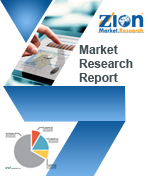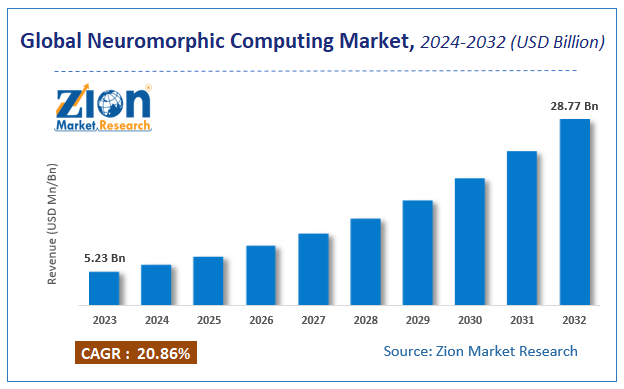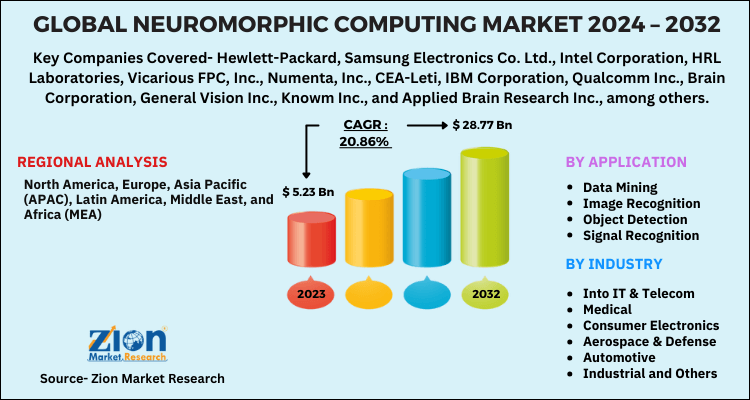Neuromorphic Computing Market Size, Share, Trends, Growth and Forecast 2032

Neuromorphic Computing Market - By Application (Data Mining, Image Recognition, Object Detection, and Signal Recognition), By Industry (IT & Telecom, Medical, Consumer Electronics, Aerospace & Defense, Automotive, Industrial, and Others), and By Region: Global Industry Perspective, Comprehensive Analysis and Forecast, 2024 - 2032
| Market Size in 2023 | Market Forecast in 2032 | CAGR (in %) | Base Year |
|---|---|---|---|
| USD 5.23 Billion | USD 28.77 Billion | 20.86% | 2023 |
Neuromorphic Computing Market Insights
According to a report from Zion Market Research, the global Neuromorphic Computing Market was valued at USD 5.23 Billion in 2023 and is projected to hit USD 28.77 Billion by 2032, with a compound annual growth rate (CAGR) of 20.86% during the forecast period 2024-2032. This report explores market strengths, weaknesses, opportunities, and threats. It also provides valuable insights into the market's growth drivers, challenges, and prospects that may emerge in the Neuromorphic Computing industry over the next decade.
Global Neuromorphic Computing Market: Overview
In the Global Neuromorphic Computing Market Report, Large integration systems containing numerous analog circuits, which replicate the neurobiological behaviors that exist in the human nervous system, and this replication is done using neuromorphic computing. They consist of two main systems that are based on the custom-made hardware architecture. These systems are made in such a way that they program the neural microcircuits and the brain-like thought process is applied in the machine learning process and cognitive computing.
Thus, owing to this, the machine learns, functions, and adapts itself like a human brain. Neuromorphic computing systems are devices that are brain-inspiring and are capable of high-speed simulations and low energy. SpiNNaker system and BrainScaleS are the two neuromorphic computing systems.
Global Neuromorphic Computing Market: Dynamics
The rise in the demand for artificial intelligence has triggered the global neuromorphic computing market. For the reverse-engineering of the human brain, the industry vendors are concentrating on the development of the neural processing unit that can be included in the processor chip. The global market is growing owing to the increase in demand for brain and cognitive robots. Various industrial sectors such as automotive, electronics, and robotics are making use of neuromorphic computing technology, hence positively impacting global market growth. Other verticals that are driving the demand are satellite imagery and aerial surveillance.
The growth in signal processing and audio processing applications is positively impacting the industry. The segment that holds the largest share in the global market growth is consumer electronics. Neuromorphic computing is used in the smart and self-driven vehicles which are bringing the transportation segment to the next level. The factor that is restraining the growth of the global market is the shortage of investments in research and development works. The other factor is that complex algorithms and upgraded software are required to make the chips, which is challenging the global market growth.
Global Neuromorphic Computing Market: Segmentation
The global neuromorphic computing market is segmented on the basis of application, industry, and region.
On the basis of application, the global neuromorphic computing market is segregated into data mining, image recognition, object detection, and signal recognition. Based on the industry, the global market is categorized into IT and telecom, medical, consumer electronics, aerospace and defense, automotive, industrial, and others.
Neuromorphic Computing Market: Report Scope
| Report Attributes | Report Details |
|---|---|
| Report Name | Neuromorphic Computing Market |
| Market Size in 2023 | USD 5.23 Billion |
| Market Forecast in 2032 | USD 28.77 Billion |
| Growth Rate | CAGR of 20.86% |
| Number of Pages | 185 |
| Key Companies Covered | Hewlett-Packard, Samsung Electronics Co. Ltd., Intel Corporation, HRL Laboratories, Vicarious FPC, Inc., Numenta, Inc., CEA-Leti, IBM Corporation, Qualcomm Inc., Brain Corporation, General Vision Inc., Knowm Inc., and Applied Brain Research Inc., among others |
| Segments Covered | By Application, By Industry, And By Region |
| Regions Covered | North America, Europe, Asia Pacific (APAC), Latin America, Middle East, and Africa (MEA) |
| Base Year | 2023 |
| Historical Year | 2018 to 2022 |
| Forecast Year | 2024 - 2032 |
| Customization Scope | Avail customized purchase options to meet your exact research needs. Request For Customization |
Global Neuromorphic Computing Market: Regional Analysis
Region-wise, the global market is segregated into North America, Europe, Asia Pacific, Latin America, and Middle East & Africa. The region dominating the global neuromorphic computing market is North America. The countries such as Mexico, the U.S., and Canada hold a major share in the global neuromorphic computing market. The major market in the North American region contributing to the global market growth is the image recognition industry.
The growing demand for automation in countries such as South Korea, China, Brazil, and India is triggering global market growth in the Asia-Pacific and South American regions. The European market is also gaining momentum owing to the rise of opportunities for neuromorphic projects.
Global Neuromorphic Computing Market: Competitive Landscape
Some main participants of the Neuromorphic Computing market are:
- Hewlett-Packard
- Samsung Electronics Co. Ltd.
- Intel Corporation
- HRL Laboratories
- Vicarious FPC, Inc.
- Numenta, Inc.
- CEA-Leti
- IBM Corporation
- Qualcomm Inc.
- Brain Corporation
- General Vision Inc.
- Knowm Inc.
- Applied Brain Research Inc.
The Global Neuromorphic Computing Market is segmented as follows:
By Application
- Data Mining
- Image Recognition
- Object Detection
- Signal Recognition
By Industry
- IT & Telecom
- Medical
- Consumer Electronics
- Aerospace & Defense
- Automotive
- Industrial
- Others
By Region
- North America
- The U.S.
- Canada
- Europe
- France
- The UK
- Spain
- Germany
- Italy
- Rest of Europe
- Asia Pacific
- China
- Japan
- India
- South Korea
- Southeast Asia
- Rest of Asia Pacific
- Latin America
- Brazil
- Mexico
- Rest of Latin America
- Middle East & Africa
- GCC
- South Africa
- Rest of Middle East & Africa
Table Of Content
Methodology
FrequentlyAsked Questions
The rise in the demand for artificial intelligence has triggered the global neuromorphic computing market. The global market is growing owing to the increase in demand for the brain and cognitive robots.
The global Neuromorphic Computing Market was valued at USD 5.23 Billion in 2023 and is projected to hit USD 28.77 Billion by 2032, with a compound annual growth rate (CAGR) of 20.86%
The region dominating the global neuromorphic computing market is North America. The countries such as Mexico, the U.S., and Canada are holding a major share in the global neuromorphic computing market.
Some main participants of the Neuromorphic Computing market are Hewlett-Packard, Samsung Electronics Co. Ltd., Intel Corporation, HRL Laboratories, Vicarious FPC, Inc., Numenta, Inc., CEA-Leti, IBM Corporation, Qualcomm Inc., Brain Corporation, General Vision Inc., Knowm Inc., and Applied Brain Research Inc., among others.
HappyClients
Zion Market Research
Tel: +1 (302) 444-0166
USA/Canada Toll Free No.+1 (855) 465-4651
3rd Floor,
Mrunal Paradise, Opp Maharaja Hotel,
Pimple Gurav, Pune 411061,
Maharashtra, India
Phone No +91 7768 006 007, +91 7768 006 008
US OFFICE NO +1 (302) 444-0166
US/CAN TOLL FREE +1 (855) 465-4651
Email: sales@zionmarketresearch.com
We have secured system to process your transaction.
Our support available to help you 24 hours a day, five days a week.
Monday - Friday: 9AM - 6PM
Saturday - Sunday: Closed






